Authentic Detroit Style Pizza Recipe: Learn How to Make It at Home
Detroit Style Pizza is undoubtedly one of the finest pan pizzas available. It delivers the perfect comfort food experience, featuring a thick, soft crumb, a crispy bottom, and an outer layer of caramelized cheese. Moreover, making a Detroit Pizza is quite simple, and once you’ve tried it, there’s no turning back
Detroit pizza is often considered the sister (or some may argue, the daughter) of Sicilian pizza, and it happens to be one of my personal favorites. Its preparation is relatively straightforward, and because it’s fermented and proofed in a pan, it’s convenient to prepare and bake.
The recipe provided below adheres closely to the original Detroit style pizza from Buddy’s, but feel free to make adjustments according to your taste preferences using the provided calculator.
Detroit pizza is best baked in a conventional home oven. it is not suited for wood-fired ovens or similar pizza ovens like Ooni or Roccbox (though it is technically possible, it is not ideal).
All of these pizzas were baked in a standard home oven
Please note that the preparation instructions in the recipe below are intended to be as general and concise as possible. Making pizza is a process, and the final result depends more on following the right technique and process than on a specific recipe. However, this recipe will guide you to excellent results, even on your first attempt
For simplicity, the recipe assumes a default fermentation time of 4 hours. However, with the dough calculator provided below, you can adjust for any fermentation time and method (cold or room temperature).
All measurements are in grams, so a kitchen scale is essential. Baking by eye or using volumetric measurements is not recommended.
Equipment Needed
Detroit pizza doesn’t require much special equipment, but one essential item is a baking pan – ideally a dedicated Detroit pizza pan. These pans have sloped sides, allowing the cheese to ‘slip’ between the dough and the pan, creating Detroit pizza’s signature feature: a crust of caramelized cheese.
I highly recommend using Lloyd’s Detroit pizza pan for the best results.
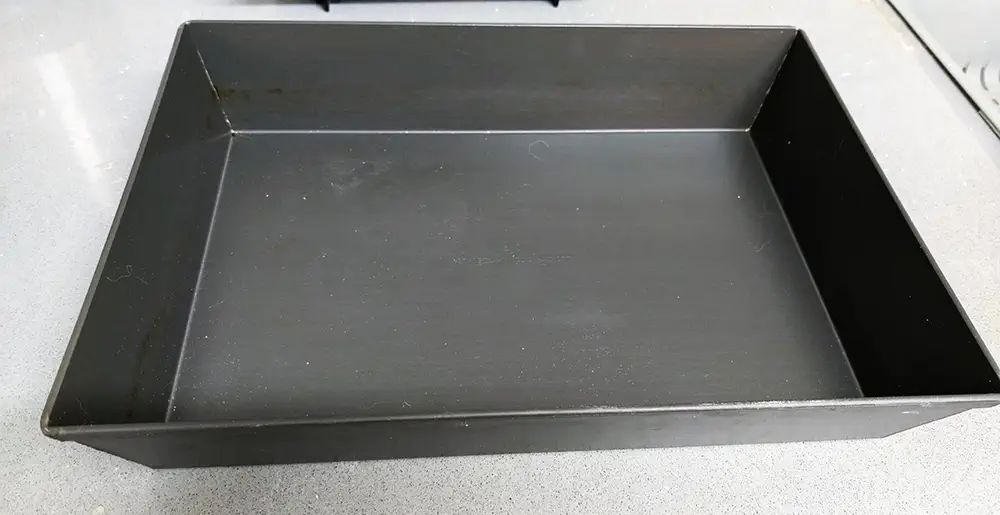
If you don’t have a Detroit pizza pan, you can use any rectangular pan. It’s best to use a dark or black pan rather than a light-colored one.
Make sure to set the pan size in the calculator below to determine the correct dough amount.
Making the Dough for Detroit Style Pizza
Dough Ingredients and Quantities (Pizza Dough Calculator)
Below is PizzaBlab’s pizza dough calculator, featuring a preset recipe formula and quantities for a 25×35 cm / 10×14” pan, designed for a 4-hour fermentation at 20°C/68°F.
It is highly recommended (and even mandatory) to:
- Adjust fermentation duration and temperature: Tailor these to your preferences so the calculator can provide the correct yeast quantity for your dough. This is crucial for achieving ideal fermentation. You can select any fermentation time and method (room temperature or cold fermentation), ranging from 2 hours to long fermentation.
- Modify the pan size: Set the dimensions according to the pan you’re using to ensure the correct amount of dough.
You can also personalize the recipe by adjusting the dough hydration (recommended between 60% and 70%), the amounts of salt, sugar, and oil, the number of pizzas, or adding a preferment.
The thickness factor (TF) is a number that measures the amount of dough needed for a specific pizza size (it does NOT represent the final thickness of the pizza). Click here to learn more about the thickness factor and how to use it.
For Detroit pizza, the default thickness factor is 0.14, which yields a classic thickness for authentic Detroit style pizza. If you prefer a thicker or thinner pizza, you can adjust the factor accordingly: use 0.16 for a thicker pizza and 0.12 for a thinner one. You can also select any value in between, such as 0.13 or 0.15.
It’s best not to exceed the above range, as doing so may result in a pizza that is either too thick or too thin.
The calculator is based on baker’s percentages. If you are not familiar with this concept, I highly recommend reading about it in the Encyclopizza, as it’s a crucial yet simple concept that will greatly enhance your baking skills.
For further details on using the calculator, you can also refer to the guide on using PizzaBlab’s dough calculator.
| Ingredient | Grams | Tsp | Tbsp |
|---|---|---|---|
| Flour (100%) | 0 | 0 | 0 |
| Water | 0 | 0 | 0 |
| Salt | 0 | 0 | 0 |
| Yeast | 0 | 0 | 0 |
| Total Dough Weight | 0 | 0 | 0 |
| Single Ball | 0 | 0 | 0 |
| Total Flour and Water (including preferment)th> | Grams | Tsp | Tbsp |
|---|---|---|---|
| Flour | 0 | 0 | 0 |
| Water | 0 | 0 | 0 |
| Preferment | Grams | Tsp | Tbsp |
|---|---|---|---|
| Flour in Preferment | 0 | 0 | 0 |
| Water in Preferment | 0 | 0 | 0 |
| Final Dough | Grams | Tsp | Tbsp |
|---|---|---|---|
| Flour (remaining) | 0 | 0 | 0 |
| Water (remaining) | 0 | 0 | 0 |
| Salt | 0 | 0 | 0 |
| Yeast | 0 | 0 | 0 |
| Total Dough Weight | 0 | 0 | 0 |
| Single Ball | 0 | 0 | 0 |
Flour for Detroit Style Pizza Dough
Any bread flour or pizza flour will work, and even all-purpose flour may be suitable. However, for the best results, it’s recommended to use flour with a high protein content, ideally 11% and higher.
For further reading on selecting pizza flour, refer to the following article: The Ultimate Guide to Pizza Flour: Characteristics, Differences, and Choosing the Ideal Flour.
Sugar and Oil in Detroit Style Pizza Dough
Sugar is included to promote browning. While it can be left out, it is not recommended to do so.
Oil is an optional ingredient. Oil is added to the recipe to create a softer, more tender crumb. Any type of oil can be used (EVOO, canola, sunflower etc.).
Mixing/Kneading the Dough
1. Prepare Ingredients: Prepare all the ingredients according to the quantities listed in the calculator.
2. Mix Water, Salt and Sugar: Start by adding the water to a bowl, followed by the salt and sugar. Mix them together until most of the salt and sugar dissolves.
If your recipe includes oil, it’s best to add it only after the flour has fully absorbed the water, as oil can inhibit gluten development. However, it is also possible to add it to the water.
3. Add Flour and Yeast: Add the flour to the bowl and sprinkle the yeast over it. Alternatively, you can dissolve the yeast directly in the water and mix well, which helps distribute it evenly throughout the dough, especially when kneading by hand. It’s ok to add the yeast directly with the salt-water mixture.
If you’re using dry yeast and cold water (below 20°C/70°F), it’s recommended to suspend the yeast in warm water (about 40°C/105°F) for about 10 minutes before adding it to the cold water. Adding dry yeast directly to cold water can damage the yeast cells and impair their ability to ferment the dough.
4. Knead the Dough: Begin kneading the dough. If you plan to ferment it for a short period (up to 3-4 hours), aim to full gluten development by the end of the kneading process (i.e., pass the windowpane test).
The longer the fermentation duration, the less kneading is required. For dough to be fermented for more than 4 hours at room temperature or cold fermented for over 24 hours, knead just until the dough becomes uniform and coherent, with a “creamy” texture (see picture below).
- If kneading by hand (recommended), mix all the dough ingredients in a bowl until the flour absorbs most of the water. Transfer the dough to a work surface and knead for approximately 5 minutes.
- If using a stand mixer, mix all the dough ingredients and run the mixer on the lowest speed (1) for 1-2 minutes, or until the water is absorbed. Then, increase to speed 2 (do not go higher!) and continue kneading for around 10 minutes. Monitor the condition of the dough; it should be relatively smooth and uniform when ready.
- If using a spiral mixer, follow the same process as with the stand mixer, kneading for about 5-10 minutes at low speed, depending on the mixer and the dough amount.
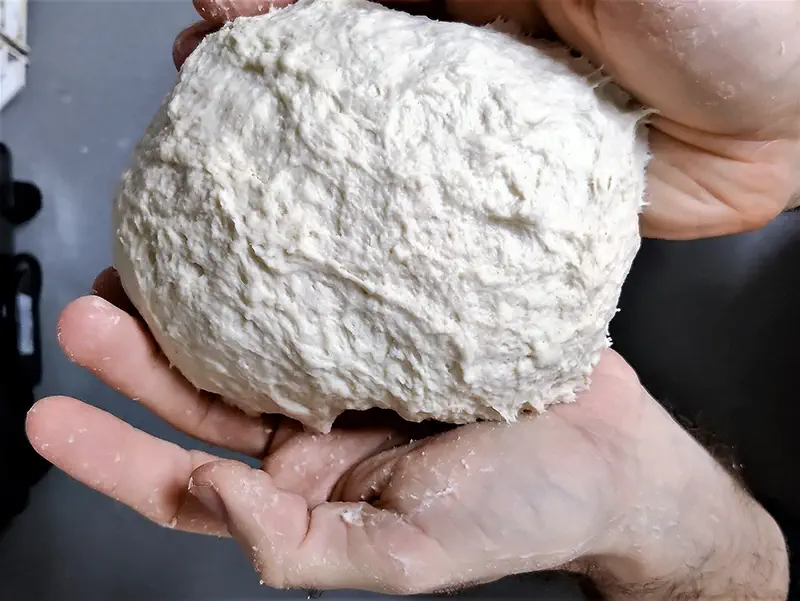
5. Final Dough Temperature: It’s recommended to aim for a final dough temperature of 23-27°C/73-80°F. This is regardless of the kneading method used.
7. Stretch and Folds: After kneading, you can do 1-2 series of stretch and folds. Be sure to wait at least 15 minutes after the initial kneading before beginning the first series to allow the gluten to ‘relax’.
8. Bulk Fermentation: Let the dough ferment for about 50% of the total fermentation time. For example, if the total fermentation duration is 6 hours, ferment the dough in bulk for 3 hours. After 3 hours, stretch the dough in the pan for final proofing (see the next section).
Stretching the Dough in the Pan and Final Proofing
1. Oil the Pan: Apply a thin layer of oil to the entire pan, including the sides. Any oil will work, but canola oil is recommended. This will help “fry” the bottom of the pizza and prevent it from sticking to the pan.
2. Transfer the Dough: Place the dough in the center of the pan. Wet your hands with water or apply a bit of oil to them. Use the palms of your hands to flatten the dough, ensuring it reaches most of the pan’s area as evenly as possible.
3. Stretch the Dough: Initially, the dough may resist and not stretch to cover the entire pan. To properly cover the surface, you will need to stretch the dough two or three times, allowing for a rest in between.
Keep in mind that right after kneading, the dough will be very elastic and resistant. You will need to stretch it inside the pan two or three times, allowing for a wait of about 20 minutes between each stretch. This resting period helps the gluten “relax,” making it easier to stretch the dough to cover the entire pan.
4. Repeat Until Covered: Continue stretching the dough until it covers the entire surface of the pan. Ensure the dough is distributed as evenly as possible without creating thin or thick spots – this is key to achieving a uniform thickness for the crust.
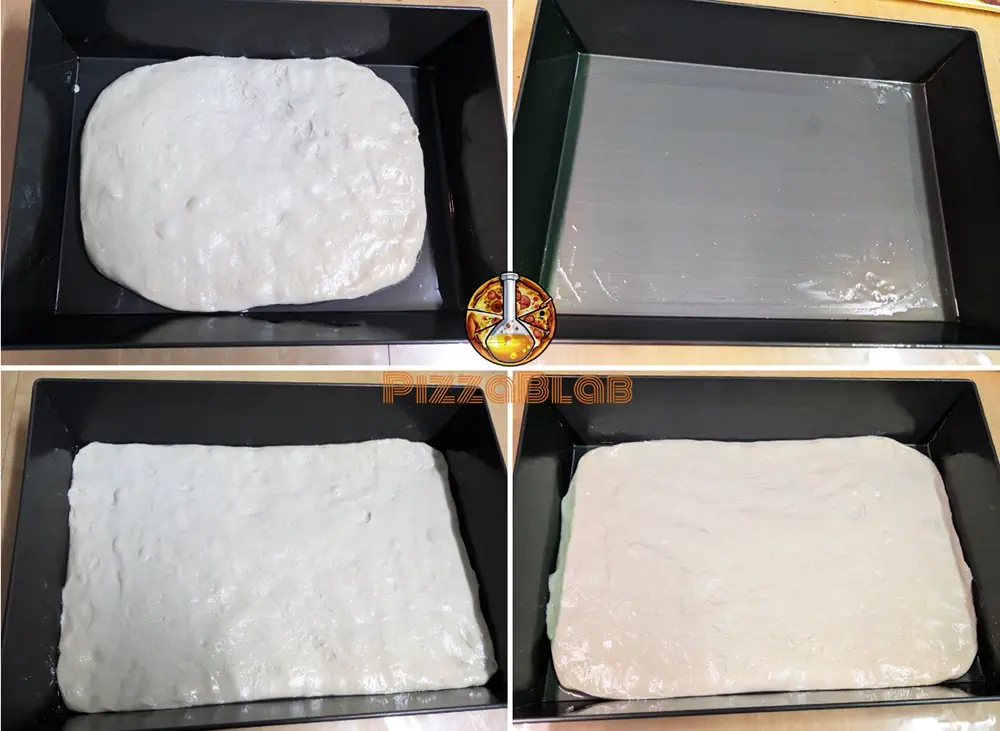
5. Final Proofing: Once the dough covers the entire pan, allow it to proof until baking. Cover the pan to prevent the surface of the dough from forming a dry crust. You can use a towel, plastic wrap, a plastic bag, or any covering that will keep air from reaching the dough – just ensure it doesn’t directly touch the dough.
Pre-Baking Preparations
Ingredients and Quantities
The amounts of sauce and cheese provided below are for a standard Detroit pizza in a 25×35 cm / 10×14″ pan. If you wish to adjust the quantities of cheese and sauce based on your preferences or different pizza/pan sizes, you can use PizzaBlab’s cheese and sauce calculator.
- 215 grams of crushed tomatoes
- 300 grams of semi-hard cheese (see the following section)
- Parmesan or pecorino cheese (optional)
Cheese for Detroit Style Pizza
Traditionally, Detroit pizza is made with a unique cheese called Brick Cheese, primarily produced in Wisconsin, USA.
Unfortunately, this cheese is not widely available outside of Wisconsin (even within the US), so you can substitute it with low-moisture (“dry”) mozzarella and/or a combination of other cheeses. For the closest experience to traditional Brick Cheese, a 50/50 ratio of low-moisture mozzarella and white cheddar works well.
The cheese can be shredded or cut into dice or strips.
It is recommended to avoid using fresh mozzarella as the main cheese, as it is not as suitable for this type of pizza. However, you can still add it in addition to shredded low-moisture mozzarella.
Additionally, it is highly recommended to grate hard cheese, such as Parmesan or Pecorino, over the pizza (before and/or after baking) to add more flavor.
Sauce for Detroit Style Pizza
The sauce for Detroit pizza, like most pizza types, is made with canned crushed tomatoes. To prepare the sauce, simply add salt to taste and optionally include a teaspoon of oregano, one clove of garlic (or garlic powder), and any other seasonings you like. Mix all the ingredients together, and the sauce is ready.
Traditionally, the sauce is pre-cooked, and poured in stripes after baking.
The sauce acts as a “weight” on the dough, preventing it from rising and gaining volume during baking. If the sauce is added before baking, the areas with sauce stripes will result in a flatter dough that hasn’t risen. Therefore, it is crucial to add the sauce only after baking.
Since the sauce is not cooked during baking (unlike other types of pizzas), it can be pre-cooked on the stove for about 10 minutes over low heat to reduce it and enhance the flavors.
Alternatively, you can add the sauce towards the end of baking (in the last 2-5 minutes). This method allows the sauce to cook in the oven, eliminating the need for pre-cooking.
Baking the Pizza
For a comprehensive guide to baking pizza in a home oven – including methods, practical tips, and techniques – check out this article (recommended): How to Bake Pizza in a Home Oven: Everything You Need to Know [A Practical Guide].
General Baking Instructions
First, preheat your oven to 270°C/520°F or to the highest temperature your oven can reach, using the upper and lower heating elements without convection.
If you have a baking surface like a stone or steel, it’s best to preheat it with the oven and bake the pizza directly on it (place the pan on the baking surface). If you don’t have one, you can place the pan on the oven’s grid or shelf, preferably on the middle or bottom shelf (see note below).
There are two methods for baking a Detroit pizza:
- Direct Baking: This is the traditional method for baking Detroit style pizza. The dough is baked with the cheese on top, and the sauce is added after baking.
- Par-Baking: The dough is initially baked “naked,” without any cheese, sauce, or toppings. The cheese, sauce, and toppings are added about halfway through baking, or after the dough has risen sufficiently but before it begins to brown.
The key difference between these methods is that direct baking (the traditional method) will result in less volume due to the weight of the cheese and toppings pressing down on the dough.
In contrast, par-baking maximizes oven spring and dough volume and allows for better control over the browning of the cheese and toppings. For example, if the cheese is browning too quickly, you can add it a little later, and vice versa.
If you prefer a crust with more volume and a lighter, fluffier texture, I recommend going for par-baking. If you want to stick to tradition, opt for direct baking.
In both methods, the total baking time should be between 10-15 minutes, depending on your oven.
The goal is for both the dough and cheese to reach their ideal doneness at the same time. The exact baking time will depend on your specific oven.
If the cheese is baking too slowly or too quickly, try experimenting with different settings, such as par-baking, adjusting the top or bottom heat, or moving the pizza to a different oven rack. While the instructions below should work well, you may need to make adjustments based on your specific setup.
If you choose to par-bake, here are several tips to maximize oven spring:
– Spray a little water on top of the dough.
– Spread a diluted sauce on the dough.
– Create steam in the oven by spraying water inside after placing the dough, or use any other method to introduce steam into the oven.
The purpose of this approach is to introduce moisture into the oven chamber (or directly onto the dough), similar to bread baking. This moisture helps delay crust formation and allows for more oven spring, resulting in a lighter and fluffier texture.
While this step is not mandatory, and excellent results can still be achieved without it, it can significantly improve texture.
Baking Instructions (Step-By-Step)
Direct Baking
1. Preheat the Oven: Ensure the oven is properly preheated.
2. Add the Cheese: Spread the cheese evenly over the entire surface of the dough, paying special attention to the sides. The goal is for the cheese to “slip” under the edges, creating a caramelized outer crust. You can also place strips of cheese next to the sides of the pan (see picture below).
3. Bake: Place the pizza in the oven and bake until the cheese and dough reach your desired level of doneness (between 10-15 minutes).
Alternatively, after 5-6 minutes, remove the pizza from the oven, add the sauce, and return it to finish baking.
It’s recommended to check the pizza every minute or two during the last 5 minutes.
Par-Baking
1. Preheat the Oven: Ensure the oven is properly preheated.
2. Par-Baking (First Bake): Bake the dough “naked,” without any cheese, sauce, or toppings. You can also spread cheese only along the sides of the pan; this will help achieve a “sharper” look for the edges. This will also prevent the dough from shrinking during baking.
3. Remove from the Oven: After 5-6 minutes, and before the top of the pizza starts to brown, remove it from the oven. The dough should have risen and appear firm, “settled,” and relatively pale (see picture below). At this stage, you can also freeze the dough or set it aside for future use.
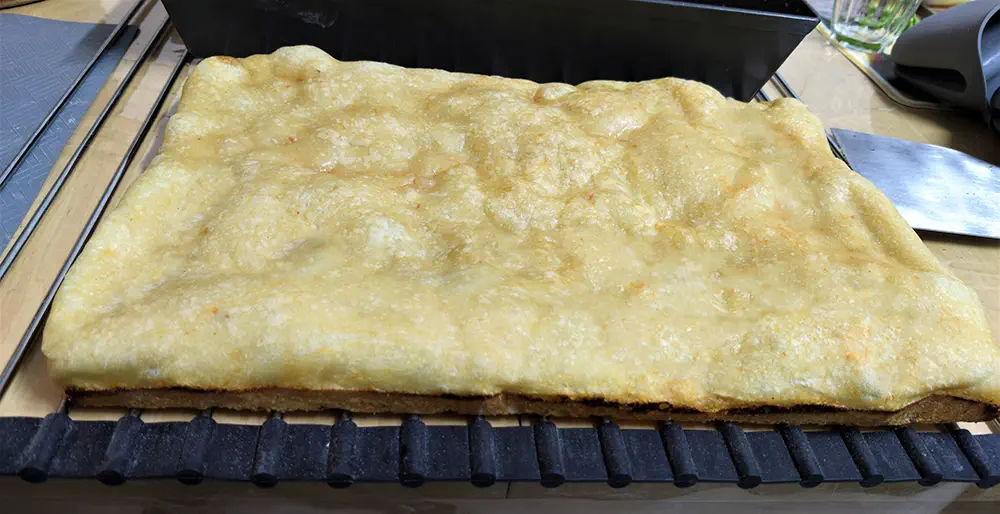
4. Add the Cheese: Evenly spread the cheese over the entire surface of the dough, focusing on the sides. The goal is for the cheese to “slip” under the edges, creating a caramelized outer crust. You can also place strips of cheese next to the sides of the pan (see picture in the next section).
5. Finish Baking: Place the pizza back into the oven and bake for approximately 5 more minutes, or until the cheese and dough reach your desired level of doneness. It’s recommended to check the pizza every minute or two during this final baking stage.
Post-Bake Instructions
1. Place the Pizza on a Cooling Rack: Once the pizza is ready, carefully remove it from the pan and place it directly onto a cooling rack or any elevated surface that allows steam to escape from the bottom. This step is crucial for maintaining the crispness of the crust.
2. Add the Sauce (for the traditional method): If you followed the traditional method of adding sauce after baking, add it now.
3. Allow the Pizza to Cool for about 5 minutes.
4. Serve: Transfer the pizza to a serving dish, cut it into equal squares and enjoy!
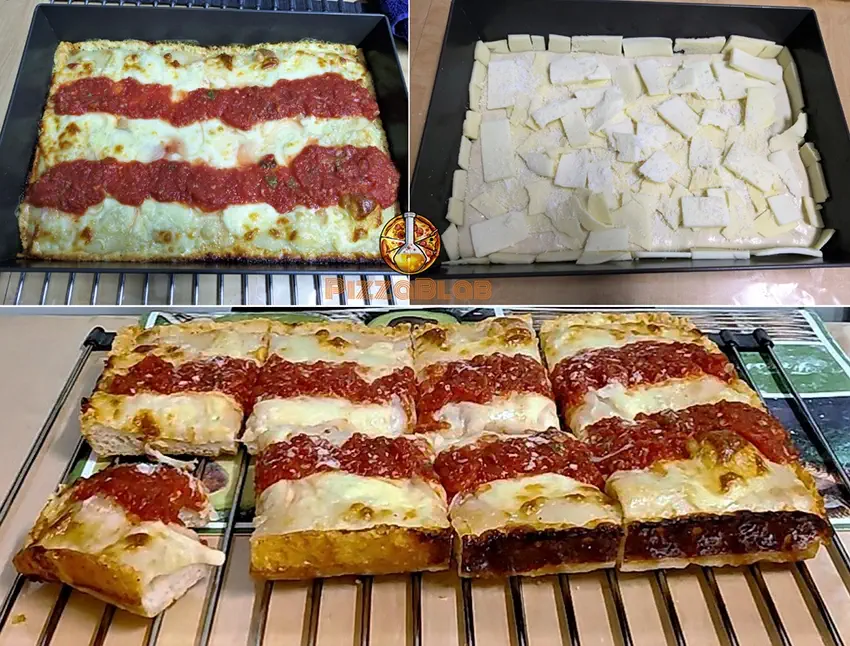
Enjoy the content on PizzaBlab? Help me keep the oven running!

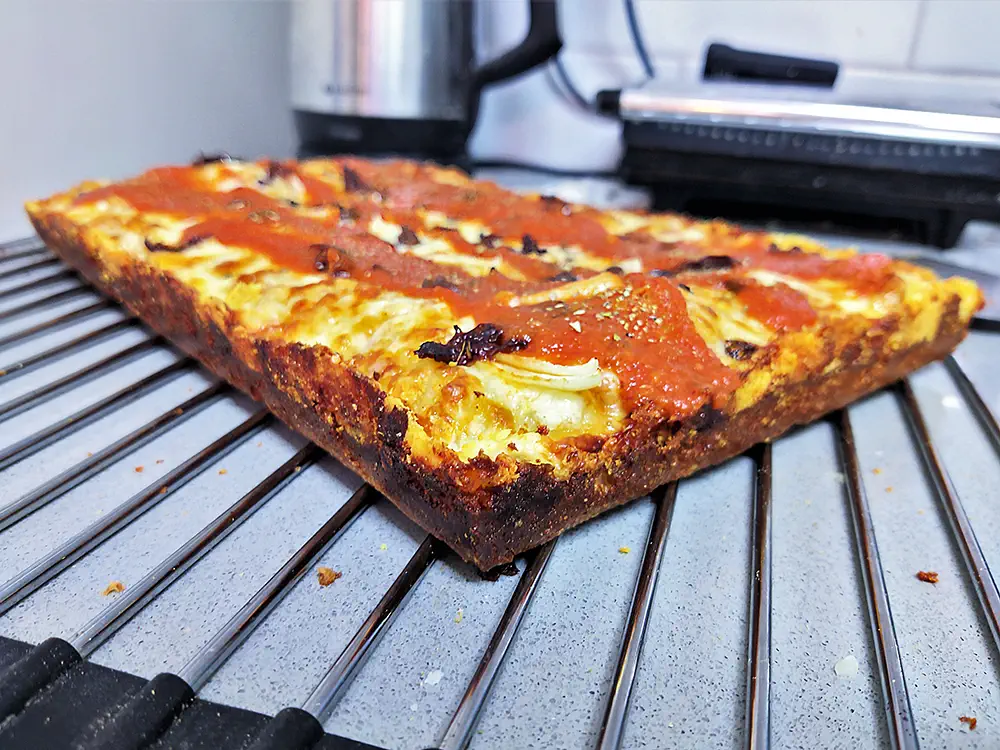
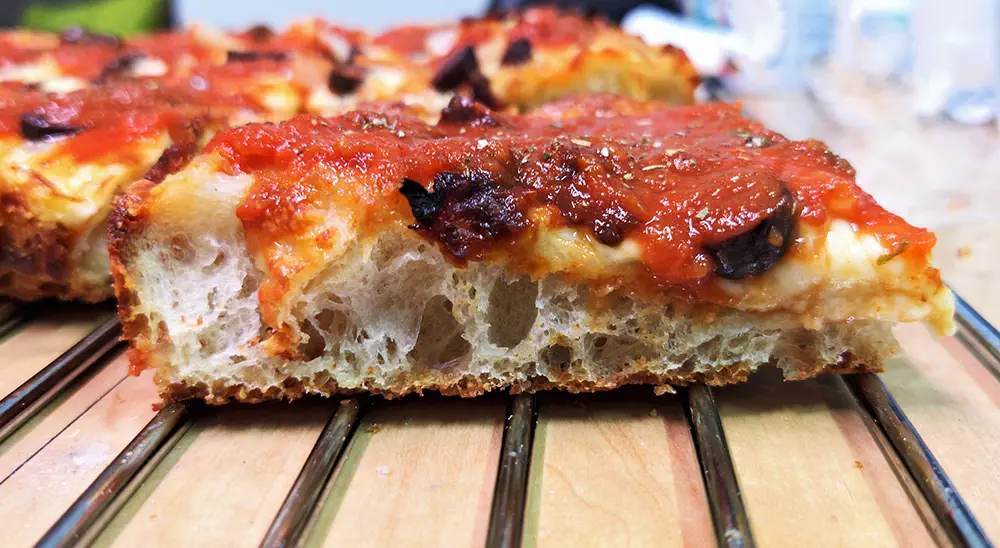
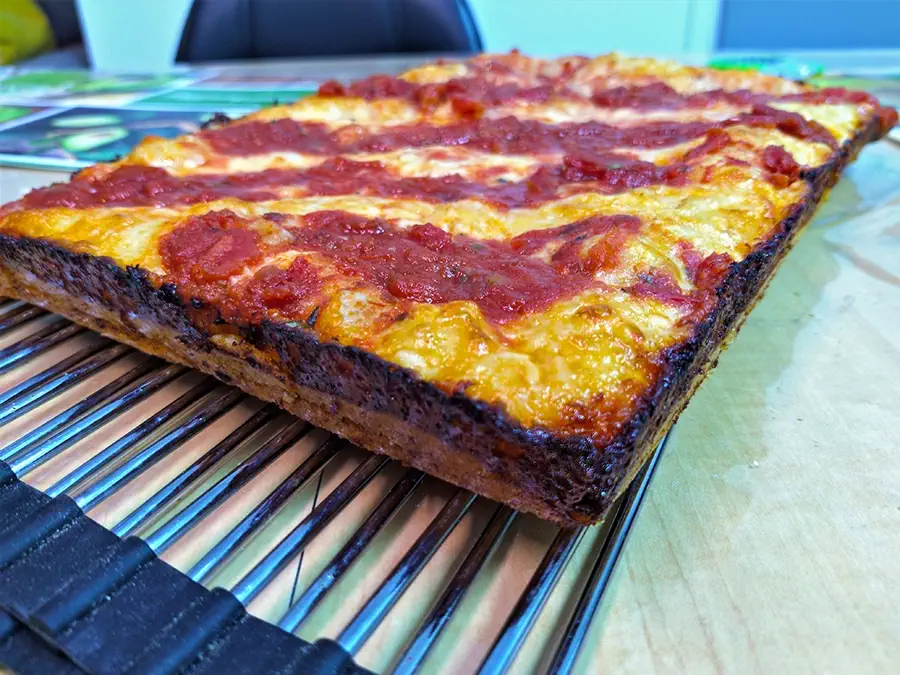

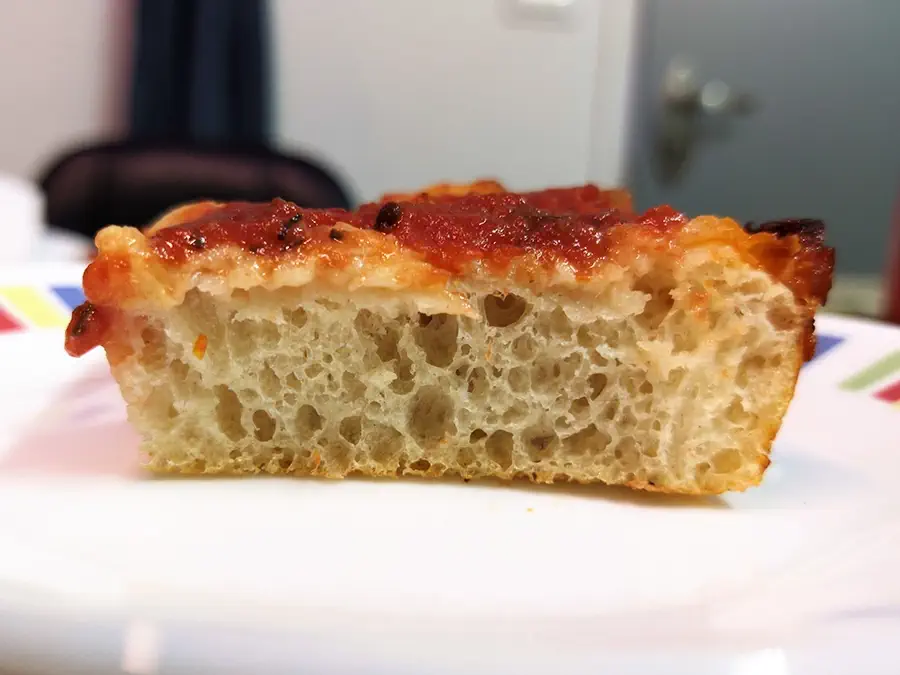

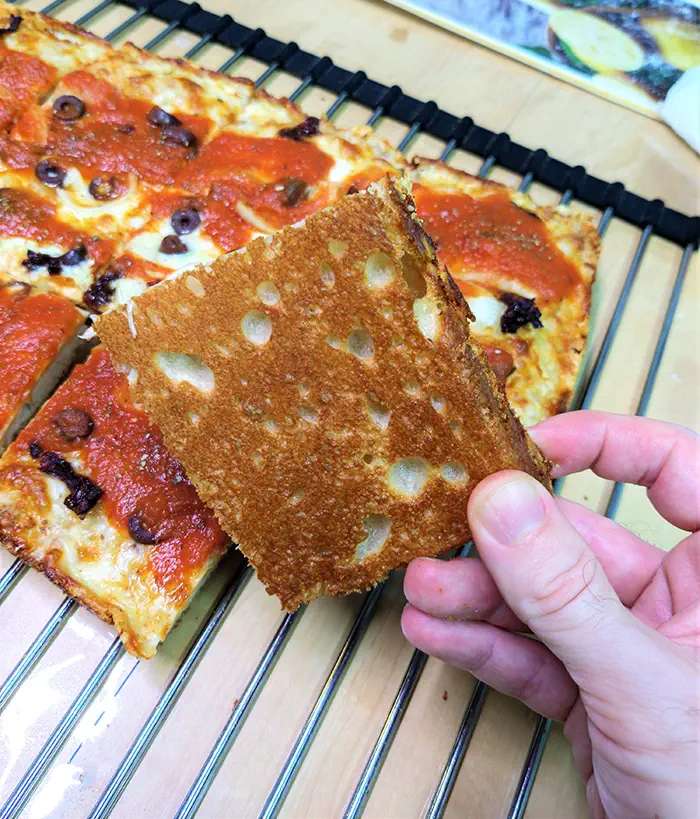
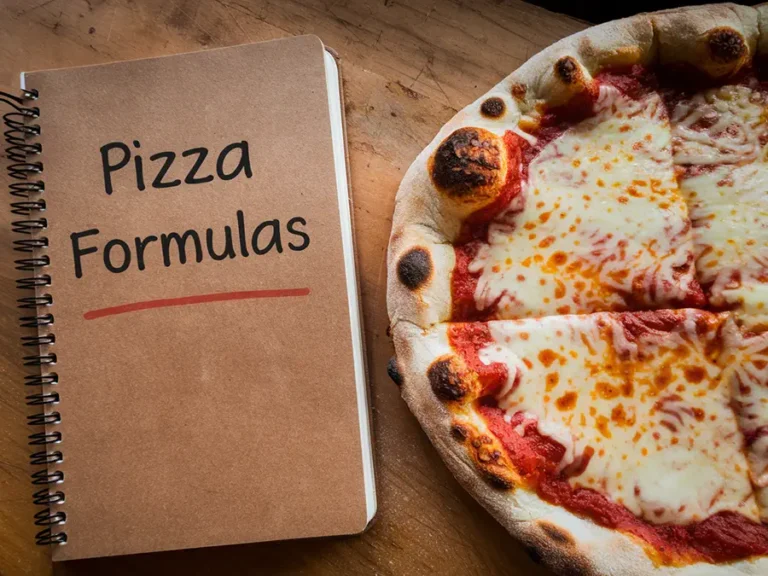

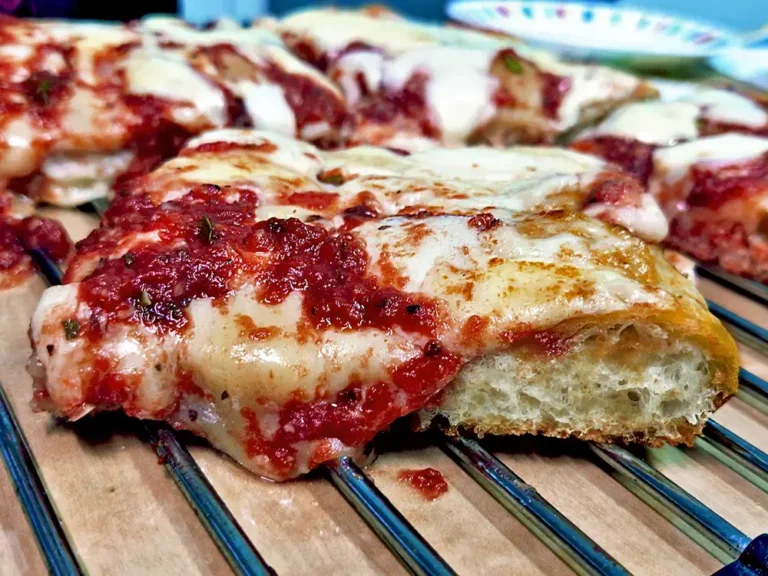
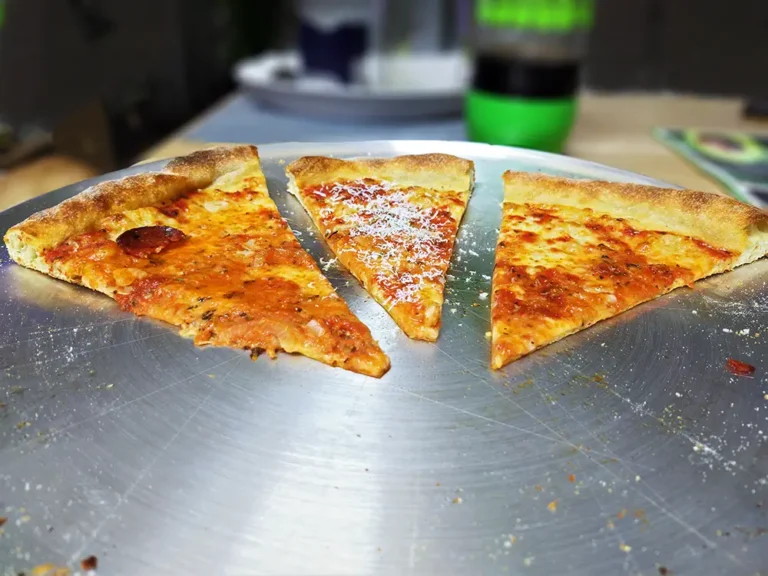

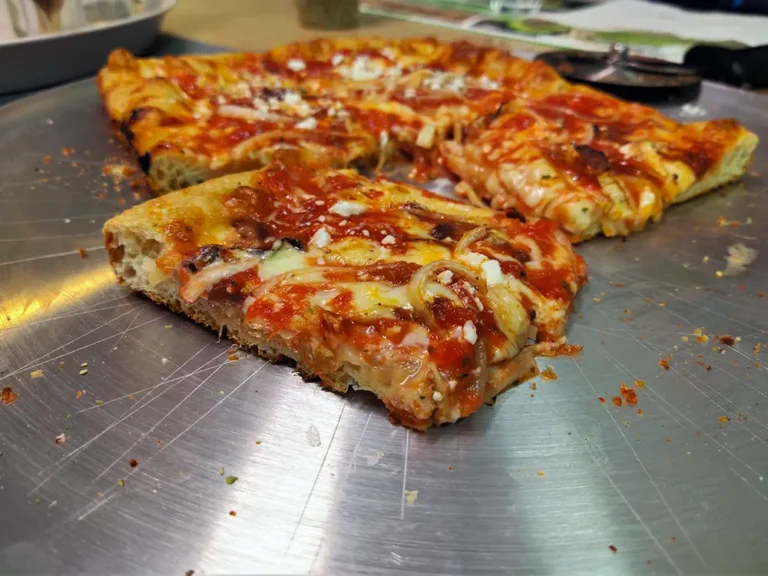
Thanks very much for this article. What a great resource this is!
🙏🏻🙏🏻
Hi, Yuval.
When cold fermenting for, say, 48 hours, do we have to bulk ferment for 24 hours on fridge, transfer it to the pan and then move it back to the fridge for the last 24 hours?
Hi Flavio,
Yes, that would generally be the ideal workflow. For cold fermentation, you could also:
1. Spread the dough in the pan immediately after kneading (no ‘bulk’ fermentation), or
2. Adjust the bulk/pan fermentation ratio (e.g., 70% bulk / 30% pan)
You’ll need to experiment to find what works best for your process. Just make sure the dough fully covers the pan whenever you transfer it.
Hey Yuval, what a great resource your site is!
I have yet to try Detroit but now i have the recipe!
Greetings
Thank you Wario!